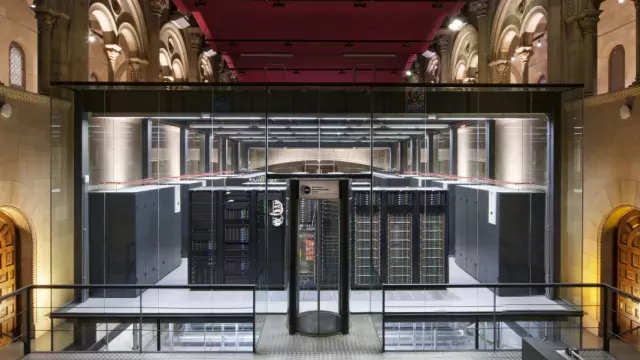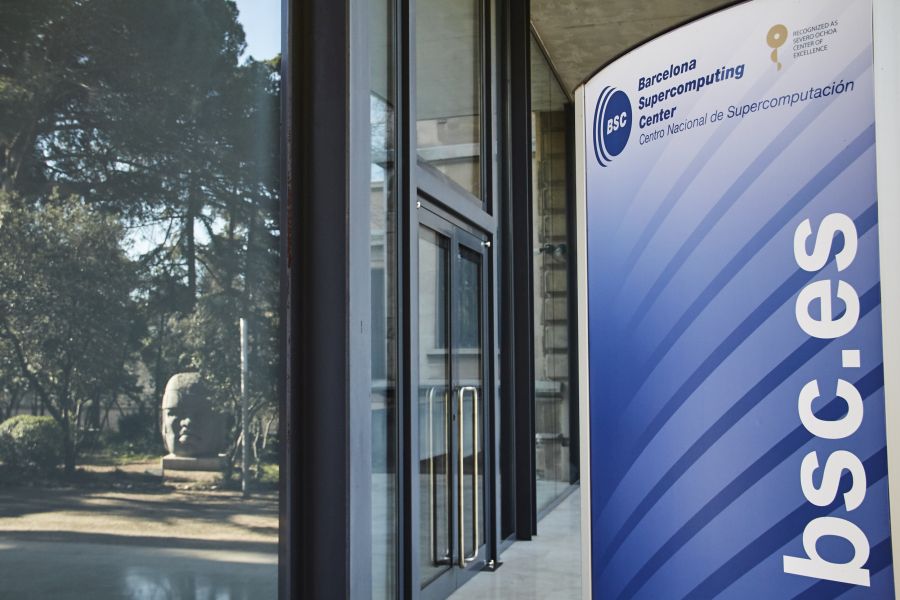In a converted 19th-century church on the outskirts of Barcelona sits a computer so overwhelmingly powerful, it could someday save us all.
Save us from what? We’re not sure yet. But one day soon a scientific or medical research breakthrough will happen and its origins will be traced back to a glass-encased room inside the Torre Girona Chapel. Sitting within is a hulking mass of supercomputing power: a whopping 3,400 servers connected by 48 kilometers of cable and wire.
Torre Girona, nestled inside the Barcelona Supercomputing Center on the campus of the Polytechnic University of Catalonia, was used as a Catholic Church until 1960. The church was deconsecrated in the 1970s but, the longer you spend here seeing how supercomputing speed can enable lightning-fast insight, the more you start to sense the presence of a higher power.
This is technology at its inquisitive best. And it all starts with the specs of the monster they call MareNostrum.
The specs
To consider the sheer power and scale of MareNostrum’s High Performance Computing (HPC) capabilities is to test your own knowledge of large-scale counting units. You see, for supercomputing nerds it’s all about FLOPs, or Floating Point Operations/Second. The original MareNostrum 1, installed in 2004, had a calculation capacity of 42.35 teraflops/second. Which meant 42.35 trillion operations/second. Not bad, I guess, until you consider that the 2017 version (MareNostrum 4) blows that out of the water – it possesses 322 times the speed of the original.
“The new supercomputer has a performance capacity of 13.7 petaflops/second and will be able to carry out 13,677 trillion operations per second,” says Lenovo VP Wilfredo Sotolongo as we gaze upwards inside the chapel. Sotolongo not only works closely with the BSC, he actually lives near Torre Girona in Barcelona.
As I try to get my head around all these unfamiliar units of measure, Sotolongo lays it out for me: “In computing, FLOPs are a measure of computer performance. Node performance…”
My mind wanders a bit before I tune back in. “A petaflop is a measure of a computer's processing speed and can be expressed as a quadrillion, or thousand trillion, floating point operations per second. A thousand teraflops. 10 to the 15th power FLOPs.” Etc etc.
He sees my head spinning so, mercifully, he simplifies it. “Basically, MareNostrum 4 is 10 times more powerful than MareNostrum 3.” OK, I can relate to that but I one-up him anyway: “How many times more powerful is it than my 2016 ThinkPad X1 Carbon laptop?” He laughs. “About 11,000 times.” Gulp.
The work
What kinds of workloads require the type of computing power found in the MareNostrum cluster? There are a lot, it turns out. Because HPC systems deliver results in a fraction of the time of a single desktop or workstation, they are of increasingly vital interest to researchers in science, engineering and business. They are all drawn by the possibility of solving sprawlingly complex problems in their respective fields.
Over the years, MareNostrum has been called on to serve more than 3,000 such projects. On any given day, as the Catalonian sun streams through the stained-glass windows of Torre Girona, MareNostrum manages mountains of data and spits out valuable nuggets of insight to a staff of more than 500 that could someday help solve some of humanity’s greatest challenges.
For example, teams in the BSC are developing HPC simulations of complex challenges in the energy and renewables sector. They are handling data for various sectors from pharma and medical to engineering, smart cities, nautical, automotive and aviation. In Earth Sciences, they are seeking solutions for problems with air quality, agriculture, weather and climate.
On the day we visited, we saw a simulation of the human heart so realistic it literally drew a gasp from our tour group. It was hard not to get fired up when learning how doctors could use this vivid way of seeing inside us to better treat those with heart ailments.
The guts
Under MareNostrum’s hood, so to speak, is a complex web of technologies sourced from three different companies. The BSC purchased a full solution from IBM that includes one major general purpose system (based on Lenovo technology) and three smaller experimental systems: one each from Lenovo, IBM and Fujitsu.
The Lenovo-provided general purpose element of MareNostrum 4 has:
- 48 racks with roughly 3,400 nodes with next-generation Intel Xeon processors and a central memory of 390 Terabytes
- Disk storage capacity of ~10 Petabytes (when connected to the Big Data infrastructure at the BSC, it’s more like 24.6 Petabytes)
- Peak power of ~11 petaflops/second, which is to say that it will be able to perform more than 11,000 trillion operations per second.
- Greater energy efficiency than MareNostrum 3
MareNostrum 4 – the new baby – has been delivered and deployed as of this writing. It faces a few tests as it is brought fully online but the BSC team say it will be completely operational before long. The technology in this room – right now untouchable and over the heads of most of us – will be put through its paces, a formidable brain in search of big problems to solve.
This article was originally published on Lenovo.com.












